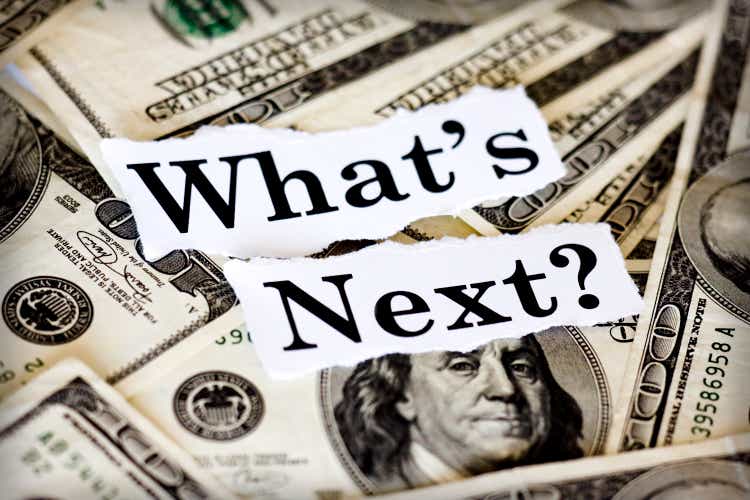MCCAIG
All things considered, it was a fairly quiet week this week for anyone not trying to trade shares of Bed, Bath & Beyond (BBBY). Meme stock mania is by no means a thing of the past! But apart from faltering companies with outdated business models rising by more than 100 percent and then falling more than 60 percent just a few days later (including the 40 percent-plus plunge during premarket trading this morning) – well, as we noted in our piece last week, the dog days are here. It may be a good time to sit back and think about things… for example, where did all that recession talk of a few weeks back suddenly go?
Curve Says Yes, Spreads Say No
It was just a bit more than three weeks ago when the Bureau of Economic Analysis released its report showing that real GDP growth declined in the second quarter, the second consecutive quarter of negative growth. That result necessitated furrowed-brow musings about the R-word on those Brady Bunch-like pundit panels on CNBC, since two quarters of negative growth is commonly (though erroneously) seen as a proxy for recession. But those conversations seem to have drifted into the ether in the weeks since the BEA report.
We typically look to the bond market for clues about economic expectations, but here as well we’re not getting much more than static. The yield curve is inverted from the 6-month T-bill to the 10-year Treasury note, which would suggest that the bond market’s message is “recession ahead, batten down the hatches.” But we get a different signal entirely from risk credit spreads. Risk spreads between benchmark Treasuries and lower-rated investment grade bonds (Moody’s Baa) are right about at their 3-year averages. Meanwhile the junk bond market has rallied furiously on the back of the recent strength in US equity markets. The ICE BofA High Yield Index, which was flirting with nine percent back in June, is back down around 7.2 percent. Yes, junk bond investors are still paying below-inflation rates for holding these higher-risk securities. Relatively tight risk spreads suggest that nobody is thinking too seriously about the potential for corporate defaults, which of course tend to be higher during a recession.
All Eyes Turn to Wyoming… Again
The very sparsely populated state of Wyoming does not tend to be in the news spotlight very often. This week was a star turn for the state in the political arena as Republican congresswoman Liz Cheney lost her seat in a high-profile and controversial primary contest. Media attention will remain fixated on the Cowboy State next week as the world’s leading central bankers convene for their annual get-together in Jackson Hole. In particular, observers will be closely parsing anything Jay Powell has to say about… well, anything, but especially how his views on growth, recession and inflation translate into what action the Fed might take at its September FOMC meeting.
Right now the market is about evenly split between expectations for another interest rate hike of 0.75 percent, following from the decision at the July FOMC meeting, and 0.50 percent. Equity bulls who want to keep the recent bounce party going for a bit longer will be hoping for that latter outcome, which would also suggest that the central bank, while far from done in its efforts to bring inflation down, is mindful of the chances for a recession and the need to not overstep too far into restrictive interest rate territory.
Jobs and Earnings
But in walking that tight line between too much and too little, the Fed also needs to take note of the signals we are getting from the jobs market and from corporate earnings, neither of which seem to suggest that a recession is looming. Analyst estimates for 2022 earnings growth have come down only slightly. The current consensus is for about 8.11 percent earnings per share growth for the full year, compared to the March 31 estimate of 8.9 percent. Even more notable is the resilience of expectations for record-high profit margins. This, even as household spending patterns continue to shift away from more discretionary consumer items towards lower-margin staples. As far as jobs go, nothing in the BLS report at the beginning of this month suggested that high unemployment is going to be a problem anytime soon.
What we can say for the moment is that, those consecutive negative GDP reports notwithstanding, our economy is neither currently in nor close to being in the kind of conditions normally associated with a recession. We do not see a compelling reason why, if the Fed wants to push all of its inflation-fighting buttons sooner rather than later, it should do anything other than another 0.75 percent hike in September. That plus a couple more CPI reports moving in the same direction as last Wednesday’s July report, would suggest to us a path forward to a resumption of moderate growth with moderate inflation. That may not sound all that exciting, but it is preferable to the alternative of stagflation – or a deep recession.
Editor’s Note: The summary bullets for this article were chosen by Seeking Alpha editors.


Be the first to comment